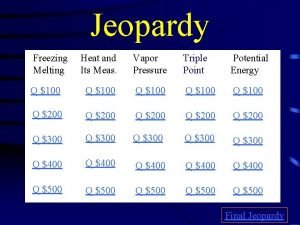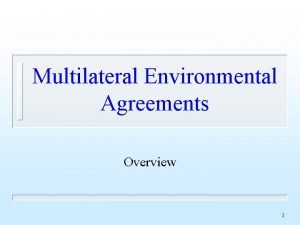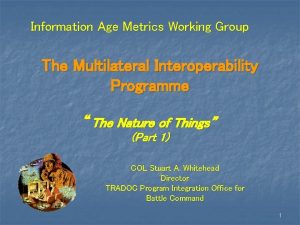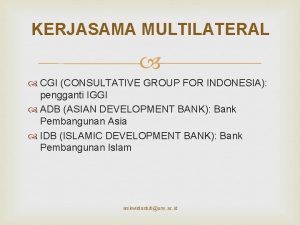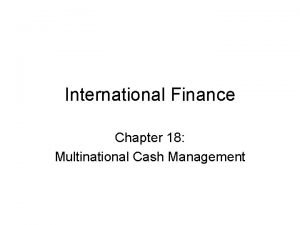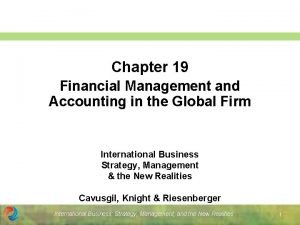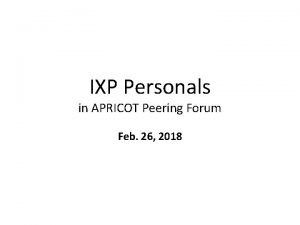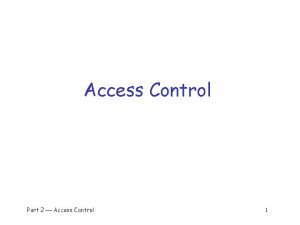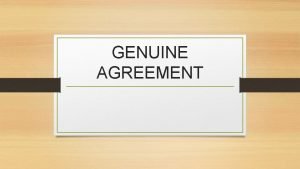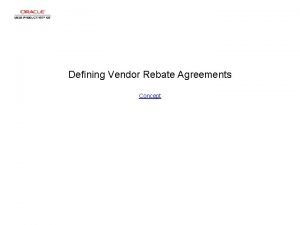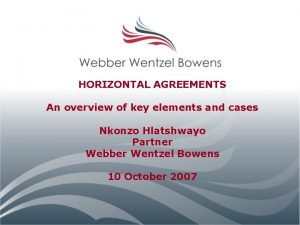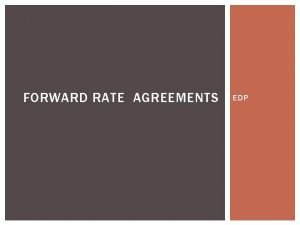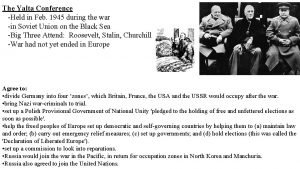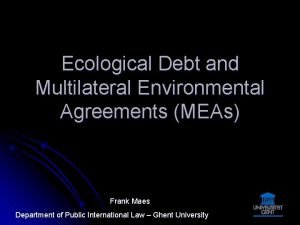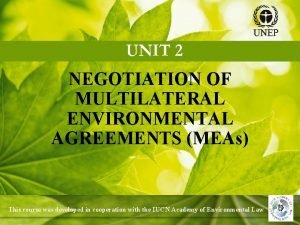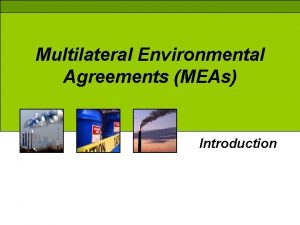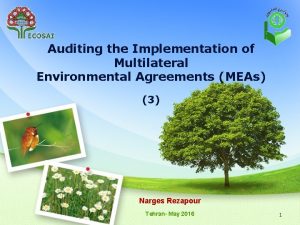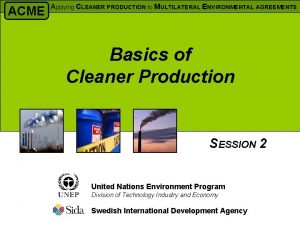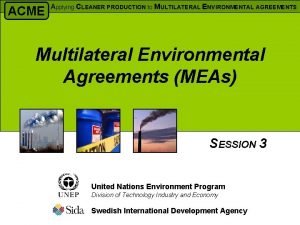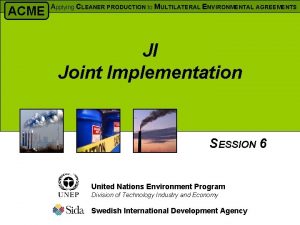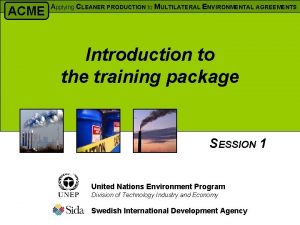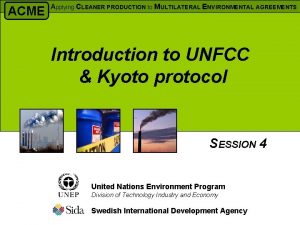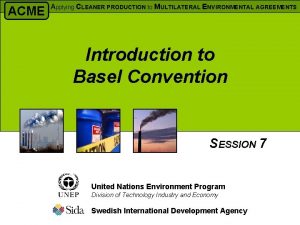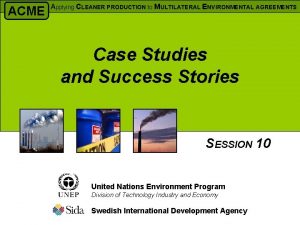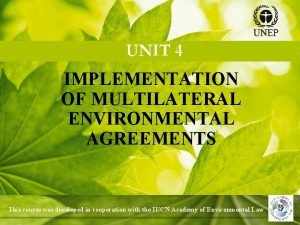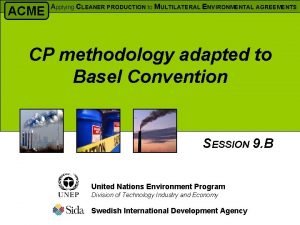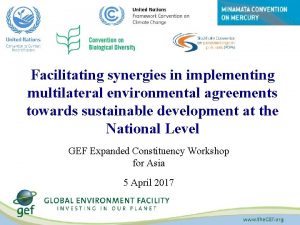Multilateral Environmental Agreements Overview 1 What are MEAs




















- Slides: 20

Multilateral Environmental Agreements Overview 1

What are MEAs? International legal instruments that: n have a goal of environmental protection n are concluded between a large number of states or international organizations as parties concluded in written form governed by international law can be embodied in a single instrument or in two or more related instruments (framework agreements) n n n 2

Milestones in the evolution of MEAs n Stockholm Conference on the Human Development (1972): – – n first attempt to address inter-relationships of environment and development at global level adopted first global action plan for environment established the United National Environmental Program (UNEP) accelerated development of modern MEAs: more than 60% of existing MEAs are adopted after Rio The 1992 United Nations Conference on Environment and Development (UNCED): – – – national and international policies redirected towards integration of environmental, economic and development objectives Agenda 21 and Rio Declaration adopted development of new international regimes stimulated 3

Core MEAs of global significance n n negotiation, development or activities are associated with UNEP work Main clusters: n – Biodiversity – atmosphere – land – chemicals and hazardous wastes – regional seas and related 4

MEA Commonalties n Shared Goal: – n Sustainable Development Cross-cutting issue: – pollution/waste management 5

MEA Clusters: Biodiversity n n Consists of MEAs related to protection and conservation of biodiversity. Main MEA - The Biodiversity Convention Protection of biodiversity is directly relevant to pollution management and efficient use of resources, and, therefore, to Cleaner Production 6

MEA Clusters: Atmosphere MEAs aimed at protection of athmosphere from pollutants. For example: n. Montreal Protocol on Substances that Deplete Ozone Layer n. The Kyoto Protocol to the UN Framework Convention on Climate Change Implementation of the atmosphere cluster MEAs requires effective pollution management and therefore the cluster is directly relevant to Cleaner Production 7

MEA Clusters: Marine Environment n Conventions relevant to marine environment: – – 17 Regional Seas Conventions and A number of Protocols on land-based sources of pollution of marine environment Global Program of Action for the Protection of the Marine Environment from Land-Based Activities (GPA) Most MEAs in the marine cluster are multi-sectoral agreements based on precautionary and preventive approaches, therefore, Cleaner Production is relevant to these MEAs 8

MEA clusters: Chemicals & Hazardous waste n n Deal with hazardous impacts of wastes and chemical pollution Main treaties of the cluster: – – – Basel Convention on the Control of Transboundary Movements of Hazardous Wastes and Their Disposal Rotterdam Convention on the Prior Informed Consent for Certain Hazardous Chemicals and Pesticides in International Trade Stockholm Convention on Persistent Organic Pollutants (POPs). Cleaner Production is relevant to all Conventions of the cluster and helps to enchance synergies among them 9

Key concepts n Legally-binding agreements – n set commitments in form of legally-binding targets and time-tables Non-binding instruments – set out important issues and priorities, foster discussion and attention, and stimulate new thinking and development of legally-binding instruments 10

MEA Implementation n Implementation of an MEA – n Compliance – n a process of converting international commitments and requirements into national law and policy in order to induce behavioral change of target groups, i. e. those actors causing the problem in question. refers to whether the countries adhere to the agreement provisions and undertake implementation measures, including procedural measures (e. g. national reporting) Effectiveness – whether a MEAs resolved a problem that caused its creation. 11

Institutional elements of core MEAs (1) n Conference of Parties (COP) – n Secretariat – n Ultimate decision-making body on implementation and development of their respective MEAs Supports COP and performs a number of varied functions depending on the mandate of the MEA Executive and subsidiary bodies – Generally advisory in nature, report to COPs on scientific, technical, or financial matters or on implementation progress; internal or external, standing bodies or ad hoc with a limited mandate 12

Institutional elements of core MEAs (2) n Clearinghouses – n Implementation actors on national level – n Facilitate exchange of information (websites, databases operated usually by the Secretariats) Represented by the national authorities and/or institutions, training and information centres Financial mechanisms 13

Financial mechanisms n Regime Budgets – n Development Assistance – n MEAs can establish one of more of mandatory or voluntary trust funds, most often administered by the international organizations that provide the Secretariats. Budgets are proposed by Parties and approved by the COPs Funds can be provided via foundations (e. g. UN Foundation), bilateral arrangements, private sector donors and NGOs Other multilateral financing mechanisms – Global Environment Facility, The Kyoto Protocol climate-related mechanisms, the World Bank 14

Global Environment Facility n A co-financing mechanism – n GEF focal areas – n resources of developed countries, banks, NGOs, bilateral and multilateral agencies to address global environmental problems within the framework of country priorities Biodiversity, climate change, international waters, ozone depletion, POPs, land degradation. Project Eligibility – – – – Country-driven and endorsed by host Governments Produce identifiable global benefits Participation of all affected groups and transparency Consistency with the Conventions Posses strong scientific and technical merit Financially sustainable and cost-effective Include process for monitoring, evaluation and incorporation of lessons learned Play catalytic role that leverages other financing 15

Strengths and weaknesses of modern MEAs n Weaknesses: – – – n Lack of synergies among MEAs Inadequate implementation and coordination of MEAs at the national level Inadequate compliance and enforcement Lack of environmental and performance indicators to measure the effectiveness of MEAs Inadequate funding for selected MEAs Strengths: – – Growing commitment to explore synergies Increased attention to principles of precaution and prevention 16

What can Cleaner Production do? (1) Shared Goal: – Sustainable Development n For MEAs, Cleaner Production can contribute to: n – – wider use of prevention as the best strategy of environmental protection issue linkage and providing positive incentives for compliance and implementation strengthening synergies among MEAs adding flexibility to the agreements 17

What can Cleaner Production do? (2) n Cross-cutting capacity building activities of CP initiatives and MEAs : – – – – Policy advice Technical and financial assistance Assessment and management of pollution Education and awareness Information exchange Strengthened participation of all stakeholders in the decision-making International partnership 18

Implementing MEAs via CP versus traditional end-of-pipe approaches: 19

Implementing MEAs via CP versus traditional end-of-pipe approaches (contd. ) 20
 Mikael ferm
Mikael ferm Por que meas abandonado
Por que meas abandonado Heat meas
Heat meas What is meas
What is meas Load fisheriris
Load fisheriris Xxx
Xxx Unilateral competition games examples
Unilateral competition games examples Multilateral competition games
Multilateral competition games Consultative group on indonesia adalah kerjasama
Consultative group on indonesia adalah kerjasama Netting cash management
Netting cash management Multilateral netting is used primarily to
Multilateral netting is used primarily to Multilateral peering japan
Multilateral peering japan The multilateral security enforces access control
The multilateral security enforces access control Wireless health
Wireless health Wrong agreement
Wrong agreement Supplier rebate agreement
Supplier rebate agreement Horizontal agreement
Horizontal agreement Forward rate agreements
Forward rate agreements Long-term parts agreements
Long-term parts agreements Yalta conference agreements
Yalta conference agreements Win-win negotiations are also known as:
Win-win negotiations are also known as:


